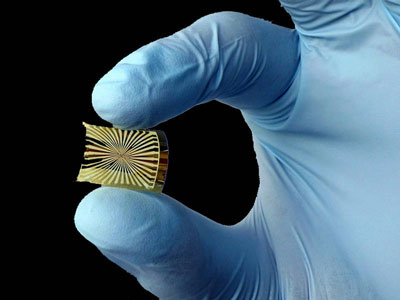| Posted: Aug 07, 2014 |
Artificial retina: A graphene interface to the optical nerve
|
|
(Nanowerk News) Physicists at Technische Universität München (TUM) are using the special properties of graphene to produce key elements of an artificial retina. With their research program the researchers were admitted to the heavily funded "Graphene" Flagship Program of the EU.
|
 |
| Graphene electronics can be prepared on flexible substrates. Only the gold metal leads are visible in the transparent graphene sensor. (Photo: Natalia Hutanu/TUM)
|
|
Graphene is viewed as a kind of "miracle solution": It is thin, transparent and has a tensile strength greater than that of steel. In addition, it conducts electricity better than copper. Since it comprises only a single layer of carbon atoms it is considered two-dimensional. In 2010 the scientists Andre Geim and Konstantin Novoselov were awarded the Nobel Prize for their ground-breaking work on this material.
|
|
In October 2013, the "Graphene" project was selected alongside the "Human Brain Project" as a Flagship Project of the EU FET Initiative (Future and Emerging Technologies). Under the supervision of Chalmers University of Technology in Sweden, it bundles the research activities and will be funded with one billion euro over ten years. In July 2014 the program took on 66 new partners, including the TUM.
|
|
Optical prostheses for blind people
|
|
Because of its unusual properties, graphene holds great potential for applications, especially in the field of medical technology. A team of researchers led by Dr. Jose A. Garrido at the Walter Schottky Institut of the TUM is taking advantage of these properties. In collaboration with partners from the Institut de la Vision of the Université Pierre et Marie Curie in Paris and the French company Pixium Vision, the physicists are developing key components of an artificial retina made of graphene.
|
|
Retina implants can serve as optical prostheses for blind people whose optical nerves are still intact. The implants convert incident light into electrical impulses that are transmitted to the brain via the optical nerve. There, the information is transformed into images. Although various approaches for implants exist today, the devices are often rejected by the body and the signals transmitted to the brain are generally not optimal.
|
|
Excellent biocompatibility
|
|
In contrast to the traditionally used materials, graphene has excellent biocompatibility thanks to its great flexibility and chemical durability. With its outstanding electronic properties, graphene provides an efficient interface for communication between the retina prosthesis and nerve tissue.
|
|
With their ambitious research project, the TUM researchers have now secured a place in the "Graphene" Flagship Program. The TUM is also involved in the second EU Flagship Program "The Human Brain Project" – coordinating the domain "Neurorobotics".
|

